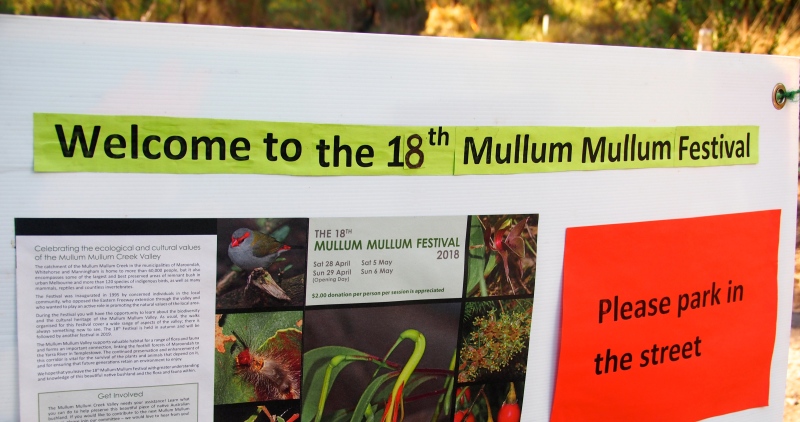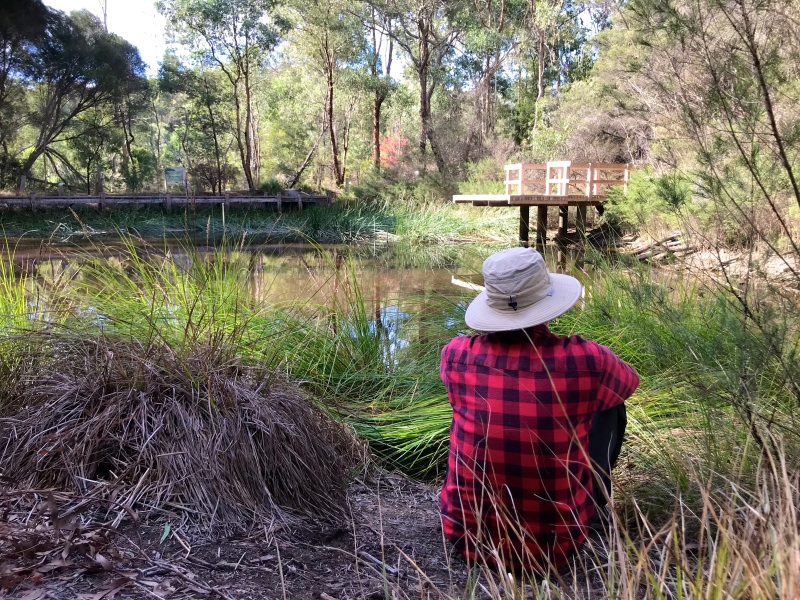
The magic of nature in an urban setting, with layers of history that stretch back to the deep past. The Mullum Mullum Valley, a precious coalition of green wedges on the outskirts of Melbourne, comprises some of the larger and better preserved areas of remnant bushland within an outer urban environment. Rich in biodiversity and ecological values, these little green ‘oases’ provide a home for native plants and habitat for wildlife and also, for visitors, a sense of peace and a welcome refuge from the pace and demands of modern life. A place to press the ‘pause’ or ‘reset’ buttons, to slow down and enjoy the natural environment and all that it offers. A chance to connect to country.

The Mullum Mullum Festival, now in its 18th year, is an annual event, held in either Autumn or Spring, celebrating the biodiversity and the ecological and cultural values of the Mullum Mullum Creek Valley. The Festival features a range of guided walks, talks and activities, held over two successive weekends. The 2018 Festival was hosted in the lead up to National Reconciliation Week, providing opportunities to learn more about Indigenous culture and history, as well as the local environment and its flora and fauna.

This year the Festival was held in Autumn, in late April/early May. The weather was kind and the range of activities proved popular. The Mullum Mullum Festival gives visitors the chance to discover, or rediscover through different eyes, these lovely urban green spaces, with the guidance of Indigenous cultural ambassadors and various experts – including local naturalists and biologists. It is all about the appreciation and exploration of the area’s natural history and heritage.

The Opening Day of the Festival was based at the Yarran Dheran Information Centre in Mitcham, on Sunday 29 April. It featured a range of activities, from morning Tai Chi to bush walks through the remnant and restored bushland, exploring everything from wetlands to mosses and fungi, from birds to water bugs and platypuses, and the geology and conservation value of the region. There were also music performances, Aboriginal demonstrations and sessions to learn about traditional arts and crafts and tool making. Poster displays, a film screening and a ‘Talking Circle’ provided opportunities to learn more about Indigenous culture and heritage and the ongoing process of reconciliation.

Below is a short video with a montage of photographs that I took of the Opening Day events.
For me, one of the highlights of the Festival’s Opening Day was the opportunity to tag along on a ‘Bush Foods Walk’ with Indigenous cultural educator, Lenka Vanderboom. On her tour Lenka pointed out the native plants that were used by the First Peoples of the area for food, fibre, medicine and tools. The walk ended with a group discussion and a cup of medicinal bark tea.
Bushland trees like the Cherry Ballart or ‘Native Cherry’ (Exocarpos cupressiformus) can be seen through different eyes once its myriad of uses are explained. Belonging to the Sandalwood family but looking a bit like a Cypress, this native plant is a benign ‘partial parasite’ that needs to form a relationship with the roots of a host plant, often a Eucalyptus, in order to grow. In Spring the ‘Native Cherries’ appear – edible small red fruits which are slightly sweet and a little salty, and unusually, with the hard nut and its seed growing on the outside rather than the inside. Indigenous people would gather the fruits and also use the strong wood to make spear throwers. The sap was used to treat snake bites, while the green branchlets were used in smoking and cleansing ceremonies.

Wurundjeri artist, Judy Nicholson and Wiradjuri craftsman, James Simons, continued the Indigenous theme, with displays of Aboriginal crafts such as weaving and ochre painting, and also boomerang, clapstick and spear making. They enjoyed being part of the day and were happy to share their knowledge about traditional crafts and answer questions about Indigenous culture and practices.
‘Murnong Dave’, an Aboriginal craftsman and educator, hosted some interesting sessions on the Indigenous weaponry of south eastern Australia, demonstrating the use of the different tools and weapons. Dave talked about how the raw materials were harvested from the landscape and how the tools were made, and then gave people an opportunity to be ‘hands on’ and make some implements for themselves.
A range of musical performances added to the atmosphere of the Festival, entertaining the audience, with featured songs by singer-songwriter, Robbie Greig and singer-percussionist, David Johnston, with break out and backing vocals from some of the Mullum Mullum Indigenous Gathering Place choristers.
Uncle John Baxter, a disability advocate and member of The Stolen Generations, gave an opening address and a beautiful ‘Welcome to Country’. He also helped to facilitate the screening of the documentary, ‘The Apology’, marking the tenth anniversary of the apology to the stolen generations.
The film was followed by a ‘Talking Circle’, with Aunty Daphne Milward, a former board member of Stolen Generations Victoria, and Howard Tankey, Mullum Mullum Festival representative and Whitehorse Reconciliation Advisory Group member. Guests were invited to ask questions and there was a discussion about the progress that has occurred over the past decade, the process of reconciliation and what still needs to take place in moving forward.
Another elder present at the Opening Day, artist Aunty Irene Norman, held some basket weaving workshops in the open space. Her table was often surrounded by visitors, keen to try their hand at the practice of weaving traditional style baskets and bowls, using various materials, like the leaves of indigenous plants and also jute and string. Aunty Irene had some beautiful examples of her weaving on display – an inspiration for the newcomers to the craft! She explained that her artwork, paintings and poetry are influenced and inspired by her connection to country.
The Mullum Mullum Festival’s Opening Day was a great community event, with a reconciliation focus and opportunities for visitors to learn more about Indigenous culture and history. The very first event of the Festival had kicked off the evening prior, with a ‘walk and talk’ spotlighting session with local naturalist, Ray Gibson. At dusk, guests went in search of nocturnal wildlife, including sugar gliders, possums, bats and owls … and they were’t disappointed!
Shining a light on Indigenous culture and heritage the following day provided a chance for visitors to talk to and hear directly from elders within our community and the young people who are following on in their footsteps, as cultural ambassadors who are willing to share their stories and history. In the process they are contributing positively towards greater community understanding and the ongoing process of reconciliation.
It was really good to see such a broad cross section of community members at the recent event and a number of council representatives, including Councillors Ben Stennett and Prue Cutts, from Whitehorse City Council. Local government grants from Whitehorse and Manningham, and support from the Maroondah City Council and the Matthews family, plus the team of volunteers on the Mullum Mullum Festival Committee, have collectively enabled the Festival to continue, and for the 18th year running, to become an important fixture on the community calendar.


More broadly, I’d like to thank all those who have been active over the years in helping to preserve and maintain these unique areas of natural heritage so that they remain as important wildlife corridors, with valuable habitat for fauna and flora, and as the precious green spaces and urban ‘oases’ that we continue to be able to access and enjoy today.

On a personal level, the Mullum Mullum Valley is quite a special place for me. It’s where I spent much of my childhood. I used to ride my horses all around this region and got to know these nature reserves and tracts of bushland quite well. Growing up on the fringes of Melbourne, it was great to be able to escape to ‘the country’. The opportunity as a child, to connect with and immerse myself in nature no doubt had a big influence on my decision to become a biologist and nature photographer.
Being able to ride horses through the Mullum Mullum Valley was one of the best things about growing up on the fringes of Melbourne. So I am thankful that these special places remain for current residents and visitors. I am also grateful to all those who lobbied hard in the 1990s to have the extension of the Eastern Freeway include an underground tunnel option as an alternative to the original plans – which would have overseen the destruction of large tracts of the remnant bushland for roadworks.

My horses had been based in the paddocks that surrounded the historical Schwerkolt Cottage in Mitcham at the time, which backed on to the ‘Yarran Dheran’ Nature Reserve in Donvale. The name comes from a Wurundjeri term meaning ‘valley of the wattles’. I used to think about and imagine Indigenous people living along the creeks in times past, and I could almost hear their ancestors whispering to me like the wind in the leaves as I rode along the pathways.
How wonderful to meet some of the local Wurundjeri descendants at the Mullum Mullum Festival and learn about their stories, their culture and their country. I have since learned that ancient scar trees, Aboriginal camping places and spirit places of the Wurundjeri Aborigines are located along the length of the Mullum Mullum Creek. The name itself is derived from Aboriginal words meaning ‘place of many eagles and butterflies’.
Perhaps I didn’t fully realise back when I was growing up, that the Mullum Mullum Valley retains a richness of biodiversity that represents some of the plant and animal species that would have been here prior to white settlement, including important, now endangered species unique to this part of Melbourne. When the Eastern Freeway extension was proposed, an Environmental Effects Statement highlighted the ecological value of the area and the growing public concerns, which thankfully were taken into account in the final planning process and in the resulting amendments to the proposed roadworks. The foresight and actions of those scientists, conservationists and community advocates, who made a stand for the protection of this environmentally and culturally significant area, is something we can all be grateful for.
This is the legacy that the Mullum Mullum Festival continues to celebrate today – the preservation of the valley’s rich biodiversity and its ecological and cultural values. It reminds me of the lovely quote by anthropologist, Margaret Mead:
‘Never doubt that a small group of thoughtful, committed citizens can change the world …. Indeed, it is the only thing that ever has.’
………………………………………………………..
For further information about the Mullum Mullum Festival and National Reconciliation Week, visit:
https://mullummullumfestival.org.au
https://www.reconciliation.org.au/national-reconciliation-week/
The Mullum Mullum Festival respects Aboriginal culture and heritage and acknowledges the Wurundjeri people as the traditional custodians of the land known as the Mullum Mullum Valley. The significance of their story is valued and seen as an integral part of the unique character of the local area.




































































Sounds a beautiful occasion as indicated by pictures and words and good to learn that a cross section of the community were involved.
Hope to contact you in a few weeks.
Regards,
Marguerite
LikeLiked by 1 person
Thanks Marguerite – yes, it is a beautiful event. Well done to all involved in hosting it … and I look forward to the next MMF 2019! Well worth a visit to these parklands if you are yet to explore them. Cheers – Tess
LikeLike